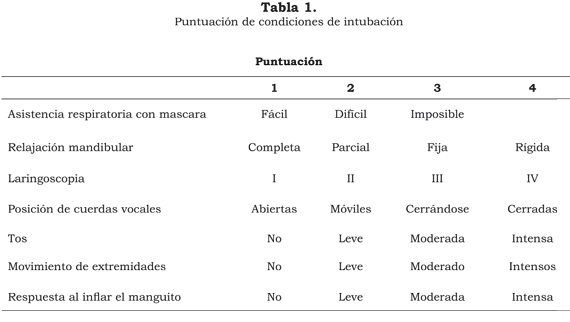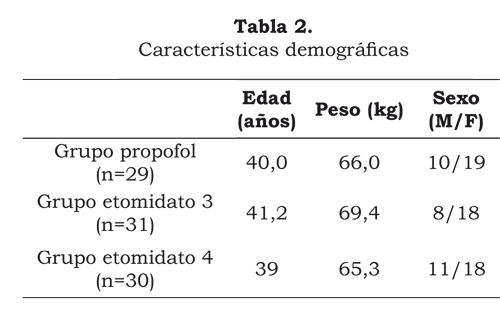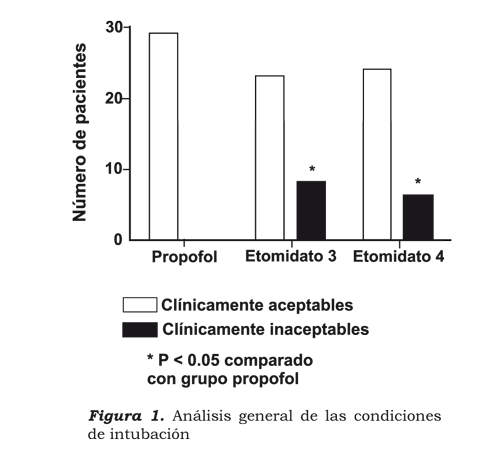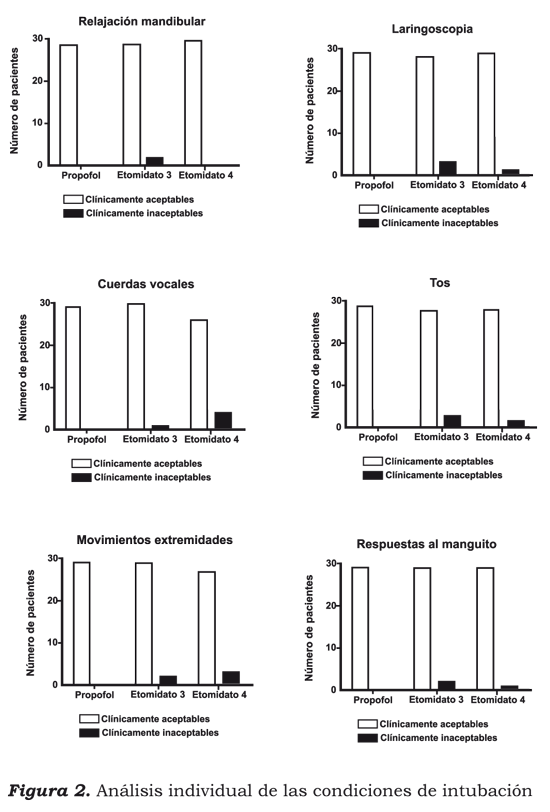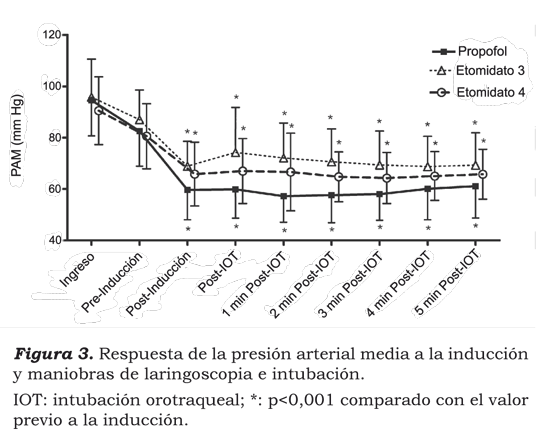Serviços Personalizados
Journal
Artigo
Indicadores
-
 Citado por SciELO
Citado por SciELO -
 Acessos
Acessos
Links relacionados
-
 Citado por Google
Citado por Google -
 Similares em
SciELO
Similares em
SciELO -
 Similares em Google
Similares em Google
Compartilhar
Colombian Journal of Anestesiology
versão impressa ISSN 0120-3347
Rev. colomb. anestesiol. v.37 n.2 Bogotá abr./jun. 2009
Orotracheal Intubation without the use of muscle relaxant: propofol or etomidate in combination with remifentanil
Jaime A. Rincón**, Angela Hernández**, Hernán Charris**, Félix R. Montes**
* Presentado en parte al congreso
anual de la American Society of Anesthesiologists (ASA), San Francisco, California,
Octubre 13-17, 2007
** MD. Departamento de Anestesiología. Fundación CardioInfantil
- Instituto de Cardiología. Universidad del Rosario. Bogotá, Colombia.
E-mail: felixmontes@etb.net.co
INTRODUCTION
An appropriate tracheal intubation requires the patient who goes under this procedure to allow the manipulation of cervical, maxillofacial and laryngeal pharynx in order to be able to visualize the glotis.1 The use of neuromuscular relaxants is quite helpful when trying to attain this objective.2 Its use has become so widely applied that it is basically now the only technique known and taught to anesthesiologists.
Such common use was the result of the fact that for many years there were no other alternatives in cases when the use of neuromuscle relaxants was contraindicated, or was not typically advised for those patients in which there is a need to avoid secondary effects of the muscular neuro-relaxant or of those medicines used for its reversion.3
With the intention to overcome such deficiency, some techniques have been developed lately, which implies the conjugation of inhaled anesthetic agents, inductive medicines and opiaceous drugs, applied in different ways without the use of the neuromuscle relaxant.1 Tyopental and propofol have been the most studied agents and this last has shown to have more mandibular relaxing capacity and laryngeal relaxing attenuation.4-11 Available literature suggests that the remifentanil is the most adequate opiaceous drugs to accompany the inductor, this due to its special pharmacokinetic characteristics and its excellent power.7,9-11
Other inducting agents that could offer additional advantages in respect to the considerable hyper tensor and cardio-depressor effect of the propofol, have hardly been investigated.7 among them, the etomidate shows to be a reasonable alternative due to its minimal effects on cardiovascular functions. 13,14
The purpose of this research is to evaluate the performance of the etomidate when associated to the remifentanil as agents to provide adequate orotracheal intubation conditions, when compared the conventional propofol-remifentanil scheme.
MATERIALS AND METHODS
After the approval given by the Ethic and Investigation Committee of our institution, and the obtainment of the documented consent from each of the participants, there were 90 ASA I-II adult patients, of both sexes studied, who were randomly programmed for surgery using general anesthesia and that would require orotracheal intubation. Excluded were those with a history of Etanol or drug abuse, cardiovascular, hepatic or renal illness, a history of gastro-esophagi reflux, hiatal hernia, bronchial hyperactivity, corporal mass index of 30 or superior, as well as patients classified with difficult airways.
Patients were randomly distributed in three groups by means of a chart generated in the computer:
- Propofol group:
control group 2 mg/kg of propropofol y 3 µg/kg of remifentanil through
an intravenous application.
- Etomidate
group 3: 0,3 mg/kg of etomidate and 3 µg/kg of remifentanil through an
intravenous line.
- Etomidate Group 4: 0,4 mg/kg of etomidate and 3µg/kg of remifentanil through an intravenous application.
Patients were taken to the surgery rooms, where arterial pressure, continuous electrographic record, pulse oximetry and the capnography were monitored in a non-invasive conventional manner. They received 0,03 mg/kg of midazolam through an intravenous line, 100% oxygen through a facial mask for a 5 minute period, and an amount of 7 ml/kg of Ringer lactate solution was administered. At the end of these five minutes, vital signs previous to the induction were recorded and the anesthetic induction took place in accordance to the following scheme:
- Remifentanil,
3 µg/kg in 90 seconds through intravenous line followed by
- lidocaine,
1mg/kg through intravenous line in 5 seconds, followed
- hypnotic through intravenous line (propofol or etemidate) in 5 seconds.
Medication was prepared by a chief nurse in the surgery room who was not part of the research. The level of unconsciousness was then determined due to response loss to orders and absence of palpebral reflex. At the moment and under the discretion of the anesthesiologist, an attempt was made to give respiratory assistance with a mask by using a Guedel oropharyngeal cannula. Forty five seconds after the hypnotic agent was applied, post-induction vital signs were registered. Ninety (90) seconds of the hypnotic agent was applied, a laryngoscope was attempted using a Machintosch blade 3 and an endotracheal tube of 7.5 mm in women and 8 m.m in men.
The anesthesiologist, who was not aware of the group the patient belonged to, graded the easiness of the respiratory assistance with facial mask, the mandibular relaxation degree, the laryngoscope according to Cormak-Lehane15, and evaluated the position of the vocal cords, the response of the patient (cough, extremities movements or both) during the orotracheal intubation and when inflating the pneumo-tamponade sleeve; this last one took place in a 5 second period. Intubating conditions were graded according to table 1.
Conditions were classified as excellent, if all criteria were graded as 1; good, if the respiratory assistance with mask was graded as 1 and other criteria as 1 or 2; and bad, if any criteria were graded 3 or 4. Patients that were not intubated in the first attempt, received 1,5 mg/kg of succinilcolina and 30 seconds after they were intubated.
To perform the analysis, the recommendation of the Conference and Consent of Copenhagen was followed, in which intubating conditions classified as excellent or good were clinically accepted and bad intubating conditions or the impossibility to carry it out were designated as clinically inacceptable. 16
Mean Cardiac rate and blood pressure were registered in the following instances;
a) When entering the surgery room immediately before administration of the inducing medication (before the induction)
b) Immediately before administration of the inducing medication (before the induction)
c) 45 seconds after the hypnotic agent bolus (after the induction)
d) Immediately after the intubation (after the intubation), and
e) Every minute during the following 5 minutes.
Besides, other events were registered such as the presence of myoclonies and fasciculations, complications such as larygeous spam bronchospam, thoracic wall rigidity. After the induction and while the evaluation time of the hemodynamic variables, 6mg of efedrina in bolus were administered through intravenous line when the mean blood pressure went down more than 30% from the initial value, or 0,5mg of atropine through intravenous line, if the heart rate was less than 45 beats per minute. After the orotracheal intubation, anesthesia was continued with sevofluorane intubation at 8% for 2 minutes and later, at 1 MAC, 100% oxygen and adjusted mechanic respiratory assistance for the normocapnia maintenance were always used. Any type of stimulus to the patient was always avoided during the research period.
Sample Size
The number of patients needed to compare the studied groups and the control group in this clinical experiment was determined taking into account the following premises.
- That the probability
of an alpha error (to falsely conclude that there are differences between the
studied group and the control group, when they do not really exist) would be
less than 0,05.
- That
the probability of a beta error (to falsely conclude that there are not differences
between the studied and control group, when indeed there are) would be 0,20.
- That
the obtained data in previous studies show that the adminsitration of the propofol/
remintalin technic provides adequate intubating conditions on 93% of the patients.7
- We will
consider as clinically important a difference of 20% in respect to this value.
- By replacing these values in a formula of an accepted sample size to compare portions in clinical experiments, we will have:

Therefore, each group should be integrated by 28 patients; as we work with three groups, 84 patients were needed.
Statistical analysis
Data was kept in a data base created for such purpose (File Maker Pro 6.0). Statistical analysis was presented as a mean ± standard deviation when the results were normally distributed and as a mean and range when they did not. Continuous demographic variables were analyzed through ANOVA. Serial data for each group were analyzed though ANOVA (repetitive measurements) followed by t matched tests with Bonferroni correction. To evaluate the differences among the group in terms of mean blood pressure and cardiac frequency, ANOVA was applied in one way followed by Tukey’s Post Hoc test when necessary. Categorical variables were analyzed with the Chi-square test. A value of p<0,05 was considered to be statistically significant. Statistical tests were carried out using the statistical package GraphPad Prism Version 4®.
RESULTS
There were not significant differences in the demographic characteristics of the groups (table 2). All patients were able to receive respiratory assistance with facial mask after the induction; however, a difficult grading was given in one patient in the propofol group, in two patients in the etomidate 3 group and in 2 patients in the etomidate 4 group (p=0,83). Facts such as mask adjustment, teeth, etc., were discarded as causes of difficulty of the respiratory assistance in those patients.
General orotracheal intubating conditions were classified as clinically acceptable in 100%, 74% and 80% of the propofol, etomidate 3 and etomidate 4 groups respectively (p=0,016) (figure 1). Discriminated analysis showed that five patients could not be intubated in the first attempt, three of which belonged to the etominate 3 group and two to the etomidate 4 group respectively (p=0,24). Main reasons for which the orotracheal intubation was unable to be performed were: inadequate mandibular relaxation ( 82 patients) and presence of closed vocal cords (3 patients); after the application of succinilcolin, these individuals were easily intubated.
No significant differences were found when individually evaluating each of the components of the intubation condition scale: mandibular relaxation, easy laryngoscope, vocal cords position, cough presence, extremity movements, and response when inflating the pneumotamponade sleeve (figure 2).
After anesthesia induction, decrease in mean blood pressure was significant in all groups (p<0,001), and such difference was maintained During the entire research period (figure 3). As we expected, this decrease was significantly higher in the propofol group as compared to the etomidate 3 group (p=0,001); however, the statistical significan ce disappeared when comparing the propofol and etomidate 4 groups (p=0,21).
From the moment of the patients’ entrance to the surgery room the cardiac frequency decreased in all groups, though only significant differences were found on blood pressure taken after the induction compared to the one taken at the moment of entrance (p<0,001 for propofol, etomidate 3 and etomidate 4). None of the patients was treated for bradicardy of less than 45 beats per minute. Due to the decrease of mean blood pressure higher than 30% in relation to the entrance, it was necessary to intervene with 6 mg of efedrin through intravenous line in four patients of the propofol group, two patients from the etomidate 3 group and in one patient of the etomidate 4 group. In the total number of patients, oxygen saturations were obtained higher than 97%, in all stages of the research.
DISCUSSION
Our results show, that 3 µg/kg of remifentanil associated to 2 mg/kg of propofol, provide significantly better orotracheal intubating conditions, in the absence of a neuromuscular relaxant when compared to the administration of 3 µg/kg of remifentanil and diverse doses of etomidate 0,3 0r 0,4 mg/kg.
These findings confirm the data reported by different researchers, who demonstrated that the use of propofol (2 a 2,5 mg/kg), associated to fentanil, alfentanil or remifentanil offer adequate orotracheal intubating conditions in patients in which no neuromuscular relaxant is used.7,9,11,17 Propofol is consistently superior when compared to tiopental, but research is quite limited when it comes to comparing it to etomidate.7,11 The main reason to study the etomidate is that this medicine is frequently the number one medication choice in patients with diminished ventricular function and whose hemodynamic stability is especially important.
In the case of the orotracheal intubation without neuromuscular relaxant, the etomidate in combination with alfentanil was studied by Stevens et al.18 They compared the conditions of intubation in patients who were administered 40 µg/ kg of alfentanil followed by 2 mg/kg of propofol, 4 mg/kg of tiopental or 0,3 mg/kg of etomidate, which provided adequate oratracheal intubating conditions. On the contrary, Erhan et al. reported that 2 mg/kg of propofol were superior to 6 mg/ kg of tiopental and 0,3 mg/kg of etomidate when combined with 3 µg/kg of remifentalin.7 Those authors found orotracheal intubating conditions clinically acceptable in 93% of the patients of the propofol group, 66,7% in the tiopental group and only in 40% of the etomidate group. Our finding partially coincide with such investigation, due to the fact that the advantages of the propofol were confirmed and that it provided adequate orotracheal intubation conditions in 100% of our patients
In our research, 0,3 mg/kg of etomidate provided acceptable orotracheal intubating conditions in 74,2% of the patients, without observing a significant improvement when increasing the dosage to 0,4%mg/kg; in this group there were acceptable clinical orotracheal intubation conditions in 80% of the patients. The best response we were able to observe with etomidate when compared to those findings made by Erhan et al.7 could be the result of using intravenous lidocaine. A cough suppressing effect because of intravenous lidocaine is recognized, though its mechanism has not been clarified.5 It has been suggested that it could be a reaction from suppressing the response of the peripheral receptors of the cough reflex, in the trachea as well as in the hypopharinx, by depression of the cerebral stem or by an increase on the depth of the general anesthesia.20,21
We do not know of studies that evaluate a dosage of 0,4 mg/kg etomidate in the case of the orotracheal intubation without neuromuscular relaxant. Etomidate can be administered safely in a higher dose than the one usually used during the induction, in an effort to maximize the anesthetic depth and avoid by this the response to the orotracheal intubation, 20 however results did not show any improvement in terms of orotracheal intubation conditions when incrementing the dose of the medicine.
As expected, mean blood pressure decreased significantly after anesthesia induction and this decrease was higher in patients that belonged to the etomidate 3 group, than in the group in which hemodynamic values remained more stable. The 0,4 mg/kg etomidate dose increase produced a decrease in mean blood pressure, slightly higher when compared to the 0,3 mg/kg group. This finding, though interesting, has been previously reported; observations carried out with etomidate 0,3 to 0,6 mg/kg range have showed modest decreases (related to the dose) of mean blood pressure and of the left ventricular function, without cardiac frequency change, cardiac index or filling pressures.23
Even though, it is clear that the use of etomidate offers more favorable hemodynamic conditions, the observed tendency reflects its low capacity to provide acceptable intubating conditions. It is evident that the increase of etomidate dose, when trying to increase its hypnotic power, did not influence the intubating conditions and, on the contrary, affected its capacity to produce a better hemodynamic stability.
It is possible then that the differences between the hypnotic power from propofol and etomidate are centered in their action mechanism and intrinsic effect and not in their dose.
In conclusion, our results show the superiority of the propofol-remifentanil scheme, to provide acceptable clinical conditions of orotracheal intubation without muscle relaxant, even though they produce a hypotensor effect, higher than the one observed with the use of etomidate on the usual 0,3 mg/kg dose. Higher etomidate dose do not contribute any advantage with respect to the intubating conditions and, on the contrary, its hemodynamic behavior is closer to that of the propofol.
Referencias
1. Rushman GB, Davies NJH, Atkinson RS. A short history of anaesthesia: intubation of the trachea. Oxford: Butterworth- Heinneman; 1996. p. 92-7.
2. Naguib M, Lien C. Pharmacology of muscle relaxants and their antagonists. En: Miller RD, editor. Anesthesia. Sixth edition. New York, NY: Pennsylvania: Churchill Livingstone Inc.; 2005. p. 481-572.
3. Naguib M, Magboul MM. Adverse effects of neuromuscular blockers and their antagonists. Drug Saf. 1998;18:99-116.
4. Scheller MS, Zornow MH, Saidman LJ. Tracheal intubation without the use of muscle relaxants: a technique using propofol and varying doses of alfentanil. Anesth Analg. 1992;75:788-93.
5. Davidson JA, Gillespie JA. Tracheal intubation after induction of anaesthesia with propofol, alfentanil and IV lidocaine. Br J Anaesth. 1993;70:163-6.
6. Hovorka J, Honkavaara P, Kortilla K. Tracheal intubation after induction of anaesthesia with thiopentone or propofol without muscle relaxants. Acta Anaesthesiol Scand. 1991;35:326-8.
7. Erhan E, Ugur G, Gunusen I, Alper I, Ozyar B. Propofol, not thiopental or etomidate, with remifentanil provides adequate intubating conditions in the absence of neuromuscular blockade. Can J Anesth. 2003;50:108-15.
8. Coghlan SFE, McDonald PF, Csepregi G. Use of alfentanil with propofol for nasotracheal intubation without neuromuscular block. Br J Anaesth. 1993;70:89-91.
9. Klemola UM, Mennander S, Saarnivaara L. Tracheal intubation without the use of muscle relaxants: remifentanyl or alfentanyl in combination with propofol . Acta Anaesthesiol Scand. 2000;44:465-9.
10. Erhan E, Ugur G, Alper I, Gunusen I, Ozyar B. Tracheal intubation without muscle relaxants: remifentanyl or alfentanyl in combination with propofol. Eur J Anaesth. 2003;20:37- 43.
11. Taha S, Siddik-Sayyid S, Alameddine M, Wakim C, Dahabra C, Moussa A, et al. Propofol is superior to thiopental for intubation without muscle relaxants. Can J Anaesth. 2005;52:249-53.
12. Stevens JB, Wheatley L. Tracheal intubation in ambulatory surgery patients using remifentanyl and propofol without muscle relaxants. Anesth Analg. 1998;86:45-9.
13. Ostwald P, Doenick A. Etomidate revisited. Current Op Anaesth. 1998;11:391-8.
14. Scheffer GJ, Voorde BJ, Karemaker JM, Ros HH, De Lange JJ. Effects of thiopentone, etomidate, and propofol on beat to beat cardiovascular signals in man. Anaesthesia. 1993;48:849-55.
15. Cormack RS, Lehane J. Difficult tracheal intubation in obstetrics. Anaesthesia. 1984;39:1105-10.
16. Viby-Mogensen J, Engbaek J, Eriksson LI, Gramstad L, Jensen E, Jensen FS, et al. Good clinical research practice (GCRP) in pharmacodynamic studies of neuromuscular blocking agents. Acta Anaesthesiol Scand. 1996;40:59-74.
17. Prakash S, Arora D, Prakash S, Bhartiya V, Singh R. A combination of fentanyl-midazolam-propofol provides better intubating conditions than fentanyl-lignocaine-propofol in absence of neuromuscular blocking agents. Acta Anaesthesiol Scand. 2006;50:999-1004.
18. Stevens JB, Vescovo MV, Harris KC, Walker S, Hickey R. Tracheal intubation using alfentanyl and no muscle relaxant: is the choice of hypnotic important? Anesth Analg. 1997;84:1222-6.
19. Yukioka H, Yoshimoto N, Nishimura K, Fujimori M. Intravenous lydocaine as a suppressant of coughing during tracheal intubation. Anesth Analg. 1985;64:1189-92.
20. Hamill JF, Bedford RF, Weaver DC, Colohan AR. Lydocaine before endotracheal intubation: Intravenous or laryngotracheal. Anesthesiology. 1981;55:578-81.
21. Woods AW, Allam S. Tracheal intubation without the use of neuromuscular blocking agents. Br J Anaesth. 2005;94:150-8.
22. Reves JG, Glass PSA, Lubarsky DA. Nonbarbiturate intravenous anesthetics. En: Miller RD, editor. Anesthesia. Sixth edition. New York: Churchill Livingstone; 2005. p. 259-60.
23. Grogan K, Nyhan D, Berkowitz DE. Pharmacology of anesthetic drugs. Cardiac Anesthesia. 5th edition. En: Kaplan JA, editor. Philadelphia, PA.: Saunders Elsevier; 2006. p. 186-7.
1. Rushman GB, Davies NJH, Atkinson RS. A short history of anaesthesia: intubation of the trachea. Oxford: Butterworth- Heinneman; 1996. p. 92-7. [ Links ]
2. Naguib M, Lien C. Pharmacology of muscle relaxants and their antagonists. En: Miller RD, editor. Anesthesia. Sixth edition. New York, NY: Pennsylvania: Churchill Livingstone Inc.; 2005. p. 481-572. [ Links ]
3. Naguib M, Magboul MM. Adverse effects of neuromuscular blockers and their antagonists. Drug Saf. 1998;18:99-116. [ Links ]
4. Scheller MS, Zornow MH, Saidman LJ. Tracheal intubation without the use of muscle relaxants: a technique using propofol and varying doses of alfentanil. Anesth Analg. 1992;75:788-93. [ Links ]
5. Davidson JA, Gillespie JA. Tracheal intubation after induction of anaesthesia with propofol, alfentanil and IV lidocaine. Br J Anaesth. 1993;70:163-6. [ Links ]
6. Hovorka J, Honkavaara P, Kortilla K. Tracheal intubation after induction of anaesthesia with thiopentone or propofol without muscle relaxants. Acta Anaesthesiol Scand. 1991;35:326-8. [ Links ]
7. Erhan E, Ugur G, Gunusen I, Alper I, Ozyar B. Propofol, not thiopental or etomidate, with remifentanil provides adequate intubating conditions in the absence of neuromuscular blockade. Can J Anesth. 2003;50:108-15. [ Links ]
8. Coghlan SFE, McDonald PF, Csepregi G. Use of alfentanil with propofol for nasotracheal intubation without neuromuscular block. Br J Anaesth. 1993;70:89-91. [ Links ]
9. Klemola UM, Mennander S, Saarnivaara L. Tracheal intubation without the use of muscle relaxants: remifentanyl or alfentanyl in combination with propofol . Acta Anaesthesiol Scand. 2000;44:465-9. [ Links ]
10. Erhan E, Ugur G, Alper I, Gunusen I, Ozyar B. Tracheal intubation without muscle relaxants: remifentanyl or alfentanyl in combination with propofol. Eur J Anaesth. 2003;20:37- 43. [ Links ]
11. Taha S, Siddik-Sayyid S, Alameddine M, Wakim C, Dahabra C, Moussa A, et al. Propofol is superior to thiopental for intubation without muscle relaxants. Can J Anaesth. 2005;52:249-53. [ Links ]
12. Stevens JB, Wheatley L. Tracheal intubation in ambulatory surgery patients using remifentanyl and propofol without muscle relaxants. Anesth Analg. 1998;86:45-9. [ Links ]
13. Ostwald P, Doenick A. Etomidate revisited. Current Op Anaesth. 1998;11:391-8. [ Links ]
14. Scheffer GJ, Voorde BJ, Karemaker JM, Ros HH, De Lange JJ. Effects of thiopentone, etomidate, and propofol on beat to beat cardiovascular signals in man. Anaesthesia. 1993;48:849-55. [ Links ]
15. Cormack RS, Lehane J. Difficult tracheal intubation in obstetrics. Anaesthesia. 1984;39:1105-10. [ Links ]
16. Viby-Mogensen J, Engbaek J, Eriksson LI, Gramstad L, Jensen E, Jensen FS, et al. Good clinical research practice (GCRP) in pharmacodynamic studies of neuromuscular blocking agents. Acta Anaesthesiol Scand. 1996;40:59-74. [ Links ]
17. Prakash S, Arora D, Prakash S, Bhartiya V, Singh R. A combination of fentanyl-midazolam-propofol provides better intubating conditions than fentanyl-lignocaine-propofol in absence of neuromuscular blocking agents. Acta Anaesthesiol Scand. 2006;50:999-1004. [ Links ]
18. Stevens JB, Vescovo MV, Harris KC, Walker S, Hickey R. Tracheal intubation using alfentanyl and no muscle relaxant: is the choice of hypnotic important? Anesth Analg. 1997;84:1222-6. [ Links ]
19. Yukioka H, Yoshimoto N, Nishimura K, Fujimori M. Intravenous lydocaine as a suppressant of coughing during tracheal intubation. Anesth Analg. 1985;64:1189-92. [ Links ]
20. Hamill JF, Bedford RF, Weaver DC, Colohan AR. Lydocaine before endotracheal intubation: Intravenous or laryngotracheal. Anesthesiology. 1981;55:578-81. [ Links ]
21. Woods AW, Allam S. Tracheal intubation without the use of neuromuscular blocking agents. Br J Anaesth. 2005;94:150-8. [ Links ]
22. Reves JG, Glass PSA, Lubarsky DA. Nonbarbiturate intravenous anesthetics. En: Miller RD, editor. Anesthesia. Sixth edition. New York: Churchill Livingstone; 2005. p. 259-60. [ Links ]
23. Grogan K, Nyhan D, Berkowitz DE. Pharmacology of anesthetic drugs. Cardiac Anesthesia. 5th edition. En: Kaplan JA, editor. Philadelphia, PA.: Saunders Elsevier; 2006. p. 186-7. [ Links ]











 texto em
texto em 

